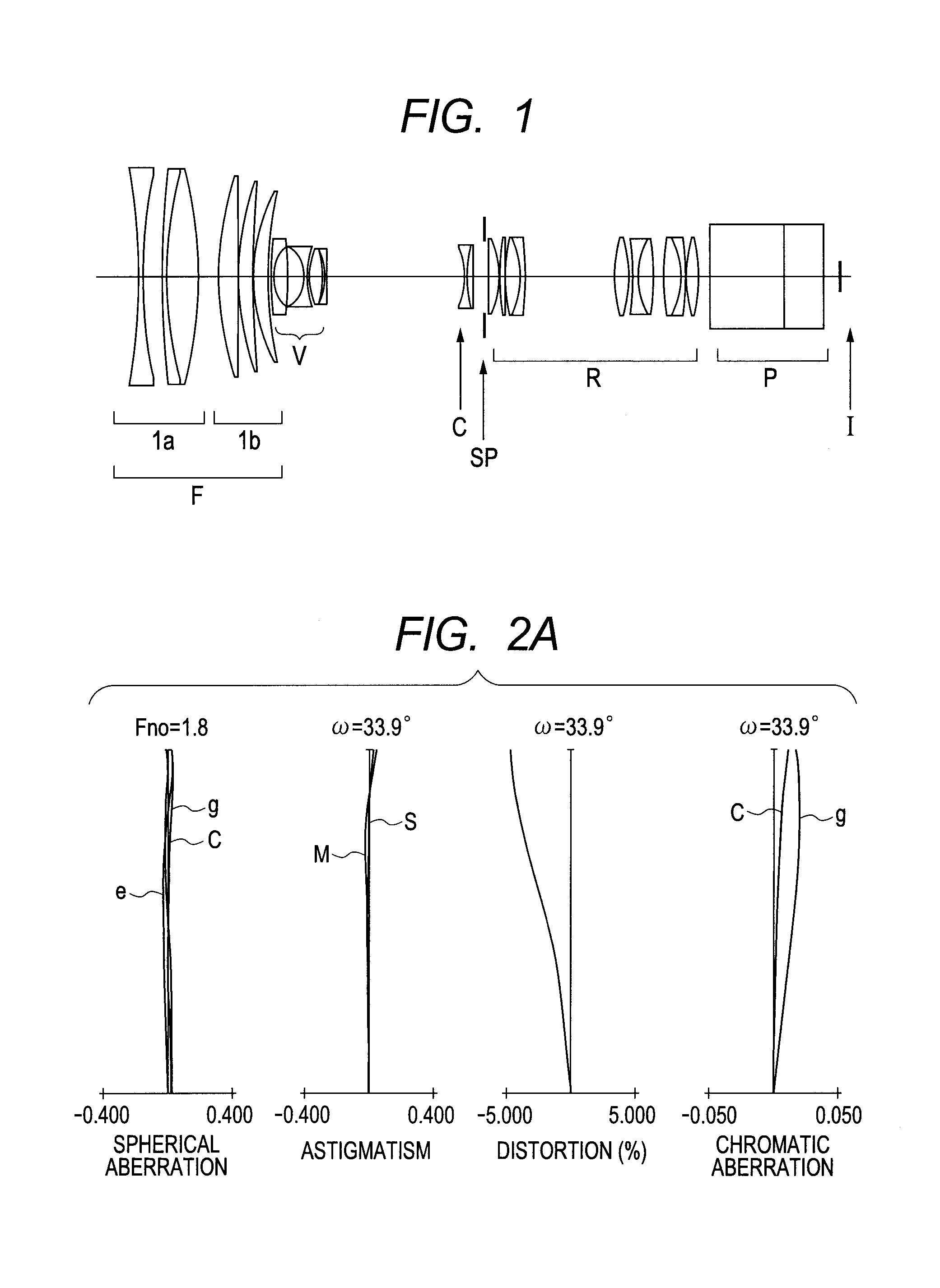Zoom lens and image pickup apparatus having the same
a pickup apparatus and zoom lens technology, applied in the field of zoom lenses, can solve the problems of insufficient aberration correction at the telephoto end, failure to achieve high performance and small size at the same time, and achieve the effect of well-corrected chromatic aberration and high performan
- Summary
- Abstract
- Description
- Claims
- Application Information
AI Technical Summary
Benefits of technology
Problems solved by technology
Method used
Image
Examples
first embodiment
[0069]FIG. 1 is a cross sectional view of a zoom lens according to numerical embodiment 1 as a first embodiment of the present invention in the state at the wide angle end. FIGS. 2A, 2B and 2C are aberration diagrams of numerical embodiment 1 respectively at the wide angle end, at a focal length f of 33.29 mm and at the telephoto end. In the aberration diagrams, curves “e” represent aberrations with respect to the e-line, curves “g” represent aberrations with respect to the g-line, curves represent aberrations with respect to the C-line, curves “M” represent aberrations in meridional image plane, and curves “S” represent aberrations in sagittal image planes. This also applies to all the embodiments described in the following.
[0070]As shown in FIG. 1, the zoom lens according to this embodiment has a front lens unit F having a positive refractive power, which constitutes the first lens unit, a variator V having a negative refractive power for varying magnification (moving for varying ...
second embodiment
[0074]FIG. 3 is a cross sectional view of a zoom lens according to numerical embodiment 2 as a second embodiment of the present invention in the state at the wide angle end. FIGS. 4A, 4B and 4C are aberration diagrams of numerical embodiment 2 respectively at the wide angle end, at a focal length f of 32.48 mm and at the telephoto end.
[0075]As shown in FIG. 3, the zoom lens according to this embodiment has a front lens unit F having a positive refractive power, which constitutes the first lens unit, a variator V having a negative refractive power for varying magnification, which constitutes the second lens unit, and a compensator C having a negative refractive power, which constitutes the third lens unit. The first lens unit F includes a sub lens unit 1a which is located closest to the object side and does not move for varying magnification or for focusing and a positive sub lens unit 1b which does not move for varying magnification but moves for focusing. The variator V moves monot...
third embodiment
[0078]FIG. 5 is a cross sectional view of a zoom lens according to numerical embodiment 3 as a third embodiment of the present invention in the state at the wide angle end. FIGS. 6A, 6B and 6C are aberration diagrams of numerical embodiment 3 respectively at the wide angle end, at a focal length f of 30.45 mm and at the telephoto end.
[0079]As shown in FIG. 5, the zoom lens according to this embodiment has a front lens unit F having a positive refractive power, which constitutes the first lens unit, a variator V having a negative refractive power for varying magnification, which constitutes the second lens unit, and a compensator C having a negative refractive power, which constitutes the third lens unit. The first lens unit F includes a sub lens unit 1a which is located closest to the object side and does not move for varying magnification or for focusing and a positive sub lens unit 1b which does not move for varying magnification but moves for focusing. The variator V moves monoto...
PUM
 Login to View More
Login to View More Abstract
Description
Claims
Application Information
 Login to View More
Login to View More - R&D
- Intellectual Property
- Life Sciences
- Materials
- Tech Scout
- Unparalleled Data Quality
- Higher Quality Content
- 60% Fewer Hallucinations
Browse by: Latest US Patents, China's latest patents, Technical Efficacy Thesaurus, Application Domain, Technology Topic, Popular Technical Reports.
© 2025 PatSnap. All rights reserved.Legal|Privacy policy|Modern Slavery Act Transparency Statement|Sitemap|About US| Contact US: help@patsnap.com



